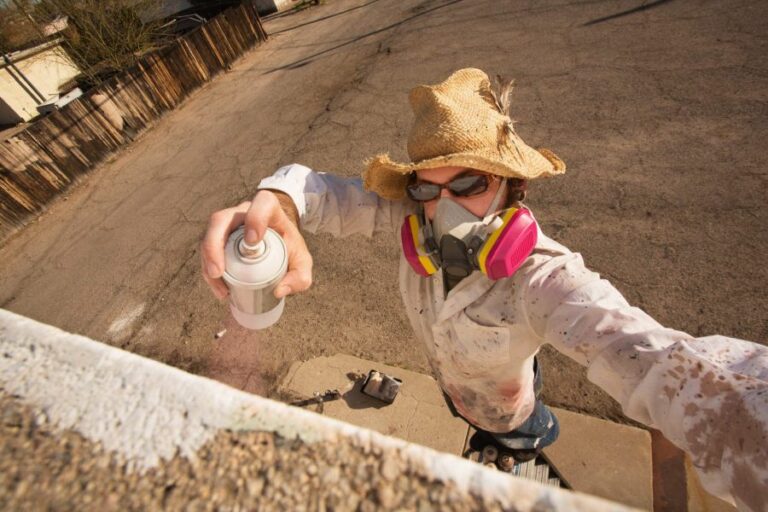Outdoor Fence Paint, 25 Things You Should Know
Are you looking to enhance your yard’s aesthetic while also protecting your fence from harsh weather and natural elements? Discover the transformative power of outdoor fence paint in my latest blog post! I’ll guide you through selecting the perfect paint, offering expert tips on application techniques, and unveiling the benefits of adding that much-needed splash of color and protection.
Outdoor fence paint:
Let’s discuss the types of outdoor fence paint, their benefits, and their proper application to ensure longevity. Latex paint is water-based, eco-friendly, and dries quickly, while oil-based paint is durable and moisture-resistant. Proper application techniques, such as surface preparation, priming, multiple coats, and using the right tools, are crucial for a beautiful and long-lasting finish. Choosing the best paint involves considering durability, ease of application, color, finish, and environmental impact. Recommendations include Behr Premium Weatherproofing Wood Stain & Sealer, Rust-Oleum Marine Topside Paint, and Valspar Duramax Exterior Paint.

Explore the world of outdoor fence paint as we unveil top products, expert application tips, and the latest trends. Beautify and protect your fence while increasing curb appeal. Discover creative techniques to elevate its aesthetic value.
Contents
- 1 Exterior Fence Painting Solution
- 2 Identifying the Optimal Choice of Paint for Exterior Fencing
- 3 Is it Necessary to Apply Primer on a Fence Prior to Painting?
- 4 What is the Most Suitable Paint for Aging Wooden Fences?
- 5 Is It Advisable to Paint My Exterior Fence?
Exterior Fence Painting Solution
I will be discussing outdoor fence paint, its types, the importance of proper application, and how to choose the best paint for your needs. I will also be offering some expert recommendations and tips on maintaining your freshly painted fence.
• Types of Fence Paint
Various types of outdoor fence paint are available in the market, and each has its own features and benefits. Here, I will discuss the primary types of paint you can consider for your fence.
– Latex Paint
Latex paint is water-based, which makes it easy to clean up and environmentally friendly. It is also user-friendly, dries quickly, and is less likely to crack or peel. Latex paint is less toxic and has a lower odor compared to oil-based paints.
However, it needs multiple coats for full coverage and durability, and the color may fade over time.
– Oil-Based Paint
Oil-based paint is more durable and long-lasting compared to latex paint. It offers a smoother finish and is resistant to moisture, making it ideal for wooden fences exposed to the elements. However, it takes longer to dry and requires the use of paint thinner for cleanup.
Both latex and oil-based paints come in a variety of finishes, including flat, satin, semi-gloss, and gloss. The type of finish can affect your fence paint’s overall appearance and durability.
• Why Proper Fence Paint Application Matters
Applying outdoor fence paint properly is critical to achieving the best results and ensuring the longevity of your paint job. Here are a few reasons why proper fence paint application is essential:
- Uniform and beautiful finish
- Long-lasting protection against the elements
- Reduced chances of peeling, flaking, and chipping
- Cost-effectiveness through reduced maintenance and repainting needs
• Expert Tips for Applying Fence Paint
Here are some useful tips for applying paint to your fence for a durable and professional finish:
– Prepare the Surface
Properly preparing the surface of the fence is key to ensuring the paint adheres well and lasts as long as possible. Clean the surface by removing dirt, debris, and mildew, and sand down rough areas, splinters, or peeling paint. This will create a smooth, clean surface for the new paint to bond with.
– Prime the Surface
Using a high-quality primer is recommended, especially for wooden fences, as it helps the paint adhere better and provides additional protection against the elements. Good primers also help in preventing tannin bleed from the wood, which can discolor your paint over time.
– Apply Multiple Coats
To ensure the best coverage and protection for your fence, apply at least two coats of paint, allowing each coat to dry completely. This helps the paint to form a strong and durable bond with the surface.
– Use the Right Tools
Using the appropriate tools, such as brushes, rollers, or paint sprayers, ensures a smooth and even finish. Choose the tool that works best for the type of paint you are using and the size and texture of your fence.
• How to Choose the Best Outdoor Fence Paint
When selecting the best outdoor fence paint, consider the following factors:
– Durability
The paint should be able to withstand the elements and protect your fence for an extended period, reducing the need for frequent repainting. Look for paints that offer UV protection, water resistance, and mold resistance.
– Ease of Application
Choose a paint that is easy to work with, especially if you are not an experienced painter. User-friendly paints, such as latex-based options, can make the job quicker and more manageable.
– Color and Finish
Your choice of color and finish will affect the overall appearance of your fence. Choose a color that complements your home or garden, and consider the type of finish you want: flat, satin, semi-gloss, or gloss.
– Environmental Impact
If you’re concerned about the environment, opt for eco-friendly paint options that contain fewer harmful chemicals and emit lower levels of volatile organic compounds (VOCs).
• Expert Recommendations
Based on personal experience, the following outdoor fence paints are recommended for their durability, ease of use, and overall satisfaction:
- Behr Premium Weatherproofing Wood Stain & Sealer: A great latex-based option for wooden fences, offering both stain and sealer benefits. It is long-lasting and available in a variety of colors.
- Rust-Oleum Marine Topside Paint: An oil-based paint that offers long-lasting durability and a smooth finish. It is particularly well-suited for fences exposed to harsh weather or water.
- Valspar Duramax Exterior Paint: Water-based paint that provides a balance of durability and ease of application, and it comes in many attractive colors.
• Maintaining Your Painted Fence
Once you’ve chosen and applied the perfect outdoor fence paint, it’s essential to maintain it to prolong its lifespan.
Routinely clean the fence by removing dirt, debris, and mildew using water and a soft-bristle brush. Inspect the fence periodically for any signs of wear, such as peeling or chipping paint, and touch up these areas as needed.
In conclusion, a well-painted and maintained fence can enhance the beauty of your outdoor space and protect your investment for years to come.
Choosing the right type of paint, following expert tips for application, and performing regular maintenance will ensure a durable and attractive finish for your fence.
Identifying the Optimal Choice of Paint for Exterior Fencing
When it comes to giving your outdoor fence a fresh coat of paint that looks great and stands the test of time, there are a few key factors to consider.
Choosing the right type of paint, preparing the fence correctly, and applying the paint properly are all essential for a long-lasting, great-looking finished product.
• Weather-Resistant and Durable Paints
To ensure a long-lasting finish, it’s essential to choose a paint specifically designed for outdoor use, as the best paint for outdoor fences must withstand the elements. Here are some recommended weather-resistant and durable paint options for your outdoor fences.
– Acrylic Latex Paint
Acrylic latex paint is one of the most popular choices when it comes to painting outdoor fences and for a good reason.
This type of paint is water-based, which makes it easy to clean up, and has fewer volatile organic compounds (VOCs) than oil-based paints. It also dries more quickly and adheres well to a wide range of surfaces, including wood, metal, and vinyl.
Moreover, acrylic latex paint is flexible, which means it can expand and contract in response to changing temperatures without cracking or peeling.
This characteristic makes it a highly durable option for outdoor fences, as it can withstand the impact of harsh weather conditions such as rain, sunlight, and temperature fluctuations.
– Oil-Based Paint
Although less commonly used for outdoor fences, oil-based paints can still provide an excellent finish if applied correctly. These paints have a reputation for being more challenging to work with than water-based alternatives, as they take longer to dry and emit stronger odors.
However, oil-based paints are known for their superior adhesion, durability, and resistance to wear and tear.
– Paint and Primer in One
For those looking to save time and effort, many paints on the market now combine the benefits of a primer and a topcoat in a single product. This type of paint can be an excellent choice for outdoor fences, as it has built-in adhesion, durability, and weather resistance.
A paint and primer in one can also help to achieve a uniform, professional finish in fewer coats.
• Preparing Your Outdoor Fence for Painting
Before applying the best paint for your outdoor fence, it is essential to take the time to prepare the surface appropriately. Proper preparation will ensure a smooth and even finish and help extend the life of the paint job. Here are some steps you should follow:
– Clean the Surface
Begin by cleaning the fence thoroughly, removing any dirt, debris, or mildew. This can be done using a garden hose or a pressure washer, depending on the level of grime build-up. If mildew is present, you should also use a mildew-killing cleaner and a brush to scrub the surface.
– Repair Any Damage
Inspect the fence for any damage, such as loose nails or screws, broken boards, or cracks. Replace or repair any damaged areas as needed to ensure a stable and even surface for painting.
– Sand and Prime
Once the fence is clean and repaired, sand the surface to create a smooth surface for the paint to adhere to. Depending on your chosen paint, a primer may also be necessary. A primer will help seal the fence’s surface and provide a base for the paint, creating a durable and long-lasting finish.
• Applying the Best Paint for Outdoor Fences
With the fence properly prepared, it’s time to apply the paint. Here are some tips for achieving the best results:
– Use the Right Tools
Choose a high-quality paintbrush, roller, or paint sprayer, depending on the size and complexity of your fence. A paintbrush is ideal for smaller, intricate areas, and a roller is for larger, flat surfaces.
A paint sprayer can be an efficient way to paint a large fence quickly, but it requires some experience to achieve a smooth, even finish.
– Apply Multiple Coats
For the best results, apply multiple coats of paint, allowing each coat to dry completely before adding the next. This will ensure a uniform finish and help increase the paint job’s lifespan.
– Choose the Right Time
Painting during suitable weather conditions is crucial, as extreme temperatures or humidity can impact the drying time and the durability of the finish. Ideally, choose a day with mild temperatures, low humidity, and no rain in the forecast.
By following these expert tips and choosing the right paint for the job, you can achieve a beautiful, weather-resistant, and long-lasting finish on your outdoor fence.
Is it Necessary to Apply Primer on a Fence Prior to Painting?
If you’re planning on refreshing the look of your fence or want to protect it from the elements, you may be wondering if priming is necessary. The short answer is: it depends. Primer can provide a solid foundation for your paint and help it last longer, but there are situations in which it may not be required.
• When Is Primer Necessary?
When painting a fence, priming is essential when:
- The wood is brand new or untreated, as the primer will help seal the wood and prepare it for paint absorption.
- The fence was previously painted or stained, and you want to change the color. A primer will help you achieve better coverage and a more even result, particularly when transitioning from a dark to a light shade.
- You’re using a type of paint that requires a primer (check the manufacturer’s instructions for guidance).
Even if none of these conditions apply to your situation, it’s worth considering a primer anyway. Priming can improve the durability and longevity of your paint job, making it more resistant to chipping, peeling, and fading.
• Choosing the Right Primer
Various types of primers are available, but they fall into two main categories: oil- and water-based (or latex) primers. Both have pros and cons, so you’ll need to choose the one best suited to your needs.
– Oil-Based Primers
- Pros: Excellent adhesion to wood surfaces, making them perfect for raw or weathered wood. They also provide a strong barrier against moisture, preventing paint from peeling or developing mildew.
- Cons: They take longer to dry and can emit strong odors. They’re also less environmentally friendly than water-based primers since they contain higher volatile organic compounds (VOCs) levels.
– Water-Based Primers
- Pros: Faster drying time, lower VOC content, and easier clean-up (with just soap and water). They’re also less susceptible to cracking and can expand and contract with the wood, making them an excellent choice for outdoor applications.
- Cons: They may not adhere as well to rough or weathered wood compared to oil-based primers.
Your paint choice will also play a role in determining the appropriate primer. Some exterior latex paints are designed to be self-priming, so you may not need a separate product in that case.
• Preparing Your Fence for Priming
Before you can apply primer, you should prepare your fence to ensure the best possible results. Follow these steps:
- Clean the fence with a power washer or a scrub brush and a mixture of warm water and mild detergent. This will remove dirt, mildew, and loose debris.
- Examine the fence for any damaged or rotten wood. Repair or replace any affected areas as needed.
- Sand the fence’s surface lightly to remove any loose or chipping paint and create a smoother surface for the primer to adhere to. Be sure to wear a mask and eye protection when sanding.
- Remove any remaining debris with a tack cloth or a damp rag.
• Applying Primer to Your Fence
Once you’ve chosen the appropriate primer and prepared your fence, it’s time to apply it. Keep these tips in mind for a successful application:
- Use a high-quality paintbrush or roller, or consider using a paint sprayer for a more efficient and even application.
- Apply a thin, even layer of primer, making sure not to overload the brush or roller. This will allow for quicker drying time and prevent drips.
- Allow adequate drying time before applying a second coat (if needed). The drying time will vary depending on the primer and the weather conditions, so be sure to follow the manufacturer’s instructions.
- After the primer has dried completely, you’re ready to apply your chosen paint or stain.
• Final Thoughts
Although priming a fence before painting isn’t always necessary, it can provide a number of benefits, including better adhesion, improved coverage, and enhanced durability. By choosing the right primer and following the proper preparation and application steps, you can help ensure a professional-looking result that will stand the test of time.
Factors | Yes | No |
|---|---|---|
Material of the fence | Wood, metal | Vinyl, composite |
Condition of the fence | Damaged or weathered surface, bare wood or metal, significant stains | Properly sealed and in good condition |
Type of paint | Oil-based or alkyd paint, elastomeric coating | Self-priming paint or paint-and-primer-in-one |
Desired finish and color | Dark, vibrant or dramatic color changes, require additional opacity for better coverage | Light, neutral or similar color to the existing surface |
What is the Most Suitable Paint for Aging Wooden Fences?
Fences are essential to our homes, serving as protective barriers and decorative elements. However, they tend to wear out over time, especially wooden fences. Choosing the right paint is crucial to breathe new life into an old wood fence and protect it from the elements.
• Types of Paint for Old Wood Fence
Before diving into specific recommendations, it’s important to become familiar with the paint options available for wooden fences. There are generally two types of paint: oil-based and water-based.
– Oil-Based Paint
Oil-based paint is a traditional choice for wooden surfaces, known for its durability and long-lasting protection. These paints are made using either linseed oil, alkyd or natural oils as a base. They provide a superior, smooth finish and are especially suited for harsh weather conditions.
Advantages:
- Highly durable and resistant to peeling and chipping
- Offers superior adhesion to the surface
- Suitable for high-traffic or harsh weather conditions
- Water-resistant when fully dried
Disadvantages:
- Long drying time, usually 24 hours or more
- Requires paint thinner for cleaning tools or spills
- Releases strong fumes during application
- Not environmentally friendly
– Water-Based Paint (Latex or Acrylic)
Water-based paints, also referred to as latex or acrylic paints, are a popular choice for painting wooden fences because they’re easy to use and offer various benefits. These paints use water as a base, making them easier to clean and better for the environment than oil-based paints.
Advantages:
- Quick drying time, typically 1-4 hours
- Easy clean-up with soap and water
- Low fumes and toxicity
- Environmental friendly
Disadvantages:
- Less durable than oil-based paints
- Prone to peeling and chipping if not applied correctly
- Less water-resistant when compared to oil-based paint
• Recommended Paints for Old Wood Fence
Now that we have an understanding of the different types of paints, let’s discuss some of the best options available on the market.
– Behr Premium Wood Coatings
Behr Premium Wood Coatings are an excellent choice for superior durability and protection. This water-based paint offers long-lasting protection for wooden fences, thanks to its advanced 100% acrylic resin formula.
Behr Premium Wood Coatings also provide UV protection and are resistant to mold, mildew, and stainings. The product is available in a wide variety of colors and finishes, making it suitable for different preferences.
Behr offers several options, including:
- Behr Premium Weatherproofing Wood Stain & Sealer
- Behr Premium Solid Color Waterproofing Wood Stain & Sealer
- Behr Premium Transparent Waterproofing Wood Finish
– Benjamin Moore Arborcoat Exterior Stain
Benjamin Moore’s Arborcoat Exterior Stains is a high-quality option for wooden fences. This water-based paint offers excellent adhesion, which prevents peeling and chipping. It also provides UV protection, resists mildew growth, and is available in various colors and finishes.
Arborcoat offers both solid and semi-transparent options to choose from based on your preference.
– Sherwin-Williams SuperDeck Exterior Paint & Stain
Sherwin-Williams offers the SuperDeck line of exterior paint and stain products specifically designed for wooden surfaces, including fences. SuperDeck products provide excellent durability, UV protection, water repellency, and ease of application.
This comprehensive range offers transparent, semi-transparent, and solid options, allowing you to choose the opacity and appearance of your old wood fence.
• Tips for Painting Old Wood Fence
With your choice of paint in hand, follow these professional tips to ensure a successful fence painting project:
- Preparation: Clean the fence thoroughly by removing dirt, debris, mold, and mildew. Use a wood cleaner and brush or power washer if necessary.
- Repair and pre-treat: Inspect the fence for damaged wood, nails, or screws, and repair any issues before painting. Apply a wood preservative and let it dry completely.
- Sanding: Sand the wood surface lightly to remove any rough spots and ensure better paint adhesion.
- Primer: Apply a high-quality wood primer to boost paint adhesion and enhance the final appearance.
- Paint application: Use a brush, roller, or sprayer to apply the paint or stain, following the manufacturer’s recommendations for the ideal number of coats and drying time.
- Maintenance: Regularly inspect the fence for any signs of wear or damage and reapply paint or stain as needed.
• Final Thoughts
In conclusion, choosing the best paint for your old wood fence involves considering factors such as the paint type, durability, ease of application, and environmental impact.
With thoughtful preparation and proper application, you can successfully revive your fence and prolong its lifespan with a fresh coat of paint.
Whether you opt for oil-based or water-based paint, always select high-quality products from trusted brands like Behr, Benjamin Moore, or Sherwin-Williams. Prep your fence well, and follow expert painting tips to ensure the best possible outcome.
Paint Type | Description | Advantages | Disadvantages |
|---|---|---|---|
Latex Paint | Water-based paint that is durable and long-lasting. | Environmentally friendly, easy to clean up, dries quickly, and resists peeling and blistering | May not adhere well to certain surfaces, potential for mildew growth |
Oil-Based Paint | Long-lasting paint that is often used on exterior surfaces. | Durable, resistant to wear and tear, and provides a smooth finish | Longer drying time, harder to clean up, may yellow over time, harmful VOCs |
Acrylic Paint | A hybrid paint that combines the benefits of oil-based and latex paint. | Water-resistant, easy to clean, excellent color retention, resists fading and chalking | May not adhere as well to certain surfaces, can be expensive |
Wood Stain | A semi-transparent or solid finish that penetrates the wood surface. | Preserves the natural grain of the wood, available in a variety of colors, can provide UV protection | May require more frequent maintenance, can darken over time |
Wood Preservative | A treatment that protects the wood from insects, mold, and decay. | Long-lasting protection, can be applied before painting or staining | Protective properties only, does not provide color or finish |
Is It Advisable to Paint My Exterior Fence?
A well-maintained outdoor fence adds an aesthetic appeal to your property and serves a functional purpose by providing security and privacy. Deciding whether to paint your fence or not may seem like a simple decision to make, but there are multiple factors to consider.
• Advantages of Painting Your Outdoor Fence
– Protection from Weather
One of the primary reasons homeowners opt to paint their fences is to protect them from harsh weather conditions.
Paint serves as a barrier against moisture and sunlight, preventing the wood from rotting or becoming discolored. This protection gives your fence a longer lifespan, saving you money on possible repairs or replacements.
– Improved Aesthetics
A fresh coat of paint can significantly improve the overall appearance of your fence. Paint allows you to choose a color that complements your home’s exterior and adds visual appeal to your property. A well-maintained fence can also boost your property’s value and make it more attractive to potential buyers.
– Easy Maintenance
Painted fences are generally easier to maintain compared to unpainted ones. The paint acts as a sealant, preventing dirt, debris, and mildew from accumulating on the wood. This means you will need to spend less time and effort in cleaning and maintaining your fence.
• Disadvantages of Painting Your Outdoor Fence
– Frequent Repainting
One of the major drawbacks of painting your fence is the need for repainting every few years. The paint’s protective layer will eventually wear down due to weather conditions and regular wear and tear, requiring you to apply a fresh coat. This can be time-consuming and can become an additional expense.
– Difficulty in Choosing the Right Paint
Selecting the right paint for your fence can be challenging due to the sheer number of available options. You need to select a paint suitable for outdoor use and formulated for wood fences. Additionally, you must ensure that the paint color matches your overall exterior theme.
– Risk of Paint Damage
Even when using high-quality paint, there is a possibility that the paint may chip, peel, or crack over time due to exposure to the elements. This may require you to touch up certain areas or in some cases, completely repaint the entire fence.
• Alternatives to Painting Your Outdoor Fence
If you are hesitant about painting your fence but still want to provide some form of protection and enhance its appearance, there are other options available.
– Staining
Staining your fence is a popular alternative to painting. Stains are available in a variety of colors and offer several benefits, such as:
- Better wood preservation, as stains deeply penetrate the wood fibers and provide protection from within
- Enhanced wood grain visibility, which can contribute to a more natural and attractive appearance
- Low maintenance requirements, as stains typically last longer than paint and deteriorate more gradually
However, it is crucial to note that not all stains are suitable for every type of wood. Therefore, you need to research and choose a stain that is compatible with your fence material.
– Sealing
Applying a wood sealer to your fence can help protect it from moisture, insects, and UV rays without changing its natural appearance. Sealers are typically clear or slightly tinted, making the wood grain visible. However, unlike paint and stains, sealers usually need to be reapplied annually or every other year, depending on the product and the local climate.
• Final Thoughts
Determining whether or not to paint your outdoor fence can be a complex decision, requiring you to consider factors such as aesthetics, maintenance, and protection. It is essential to weigh the pros and cons and evaluate your priorities before making a choice.
Moreover, exploring alternatives like staining and sealing can help you find the most suitable solution that meets your requirements and enhances the longevity and appearance of your fence.







